
Update: May 2022
I just published a post covering a number of findings from the March 2022 Product Reviews Update (the latest PRU to roll out). My analysis covers linking to multiple sellers, the use of video content, loopholes in the PRU, intent shifts, dueling machine learning algorithms, and more.
—–
The past month has really been something for site owners and SEOs… Google pushed a broad core update on November 17, 2021, right before Black Friday (which shocked many people, including me). And following the rollout of the November broad core update, Google pushed yet another major algorithm update that can impact sites during the holiday shopping season. On 12/1/21, Google rolled out the December 2021 Product Reviews Update, the second official PRU following the initial update in April 2021.
I’ll cover more about the rollout below, but Google explained it can take up to three weeks to complete. And they were right… we just heard from Google that the update has completed (exactly three weeks in). During the extended rollout, I have been heavily analyzing many sites that have been impacted and this post covers my findings. I’ll continue to update this post as I surface more findings or if we learn more about the update from Google itself.
This post contains a lot of information about the December Product Reviews Update, so I have provided a table of contents for those looking to jump around the post:
- Extended Rollout
- Periodic Refresh Still Necessary
- Google’s New Guidelines
- Surges, Drops, and Overall Volatility
- Recovery From The April PRU
- Double Hits
- Dueling Machine Learning Systems
- Will The Product Reviews Update Expand To Other Languages?
- Rich Snippets Impact
- Large Publishers With Reviews Content
- Google’s New Guidance Not Being Applied Yet
- Links Aren’t Everything
- Intent Shifting
- Reviews Content That’s Working Well
- The Wirecutter Standard
Note, I also published a companion Web Story covering key findings for site owners and SEOs. Both this post and the web story work well together if you are trying to learn more about the December product reviews update.
A Note About The April Product Reviews Update (PRU):
If you are interested in learning more about the Product Reviews Update overall, definitely check out my post about the April 2021 Product Reviews Update. I cover a number of important findings based on analyzing many sites that were impacted. I also published a companion Web Story covering top tips for site owners and affiliate marketers based on my analysis of the April PRU.
In this post, I’ll cover what I’m seeing based on the December PRU, including surges, drops, recoveries, how core updates and the Product Reviews update work together (or not), rich snippets impact, what I’m calling “The Wirecutter Standard”, and more.
First, as usual with my posts about major algorithm updates, a quick disclaimer:
I do not work for Google. I do not have access to Google’s algorithms, including the machine learning system fueling the Product Reviews Update. I did not dress up like Will Ferrell in Elf, make believe I know Santa Claus, and sing endless Christmas carols in front of Google’s Danny Sullivan’s house looking to gain access to his laptop. I might have tried, but I never executed on my plan. ;) I am simply providing what I’m seeing across many sites impacted, including review sites I’m helping across verticals, that were impacted by the April and December Product Reviews Updates.

Rollout and Refresh:
As I mentioned earlier, Google explained it could take up to three weeks for the December Product Reviews Update to fully roll out. That’s a relatively long rollout, especially compared to broad core updates which typically roll out in less than two weeks. The update began rolling out on December 1 and impacted English-language pages globally:
And again, it took exactly three weeks to fully roll out. We heard from Google’s Alan Kent on Tuesday, December 21 that the update completed rolling out:
It’s important to note that I have seen several adjustments being made by Google during the rollout. I’ve tweeted several examples of the volatility on Twitter (and you can see a few of those adjustments below). Although a number of sites impacted have leveled off, notice how search visibility reverses course for some sites, surges more, drops more, etc. It has been wild to monitor:



Also, here is my tweet thread about the December Product Reviews Update in case you want to view more of my tweets about the rollout and what I’ve been seeing:
The PRU Still Requires A Periodic Refresh:
Also, and this is important, Google still has to push a periodic refresh of the Product Reviews Update. So this is like medieval Panda where Google pushed out Panda updates every few months (before incorporating Panda into its core ranking algorithm).
So, if you’ve been heavily impacted by the December Product Reviews Update, you’ll need another refresh to see significant improvement. It’s also important to understand that Google’s John Mueller explained that he could see the Product Reviews algorithm get baked into Google’s core ranking algorithm at some point.
On that note, I’m sure Google wants to do that based on what I’m seeing with sites impacted (and how those sites are also being impacted by other major algorithm updates which sometimes go against the PRU). It doesn’t make a lot of sense and I’ll cover more about that soon in the section about dueling machine learning systems. Here is John Mueller explaining that he could see the PRU getting baked into Google’s core ranking algorithm:
And as a quick reminder, Google is evaluating sites more broadly with the Product Reviews Update (similar to how broad core updates work). For example, site or section-level evaluation. That’s why some sites can see a lot of movement with the PRU. You can read my post about the April Product Reviews Update for more information about that.
Two New Guidelines For Sites Publishing Reviews:
As a quick reminder, the Product Reviews Update is looking to reward high quality, insightful reviews versus lower-quality and thinner reviews. In Google’s original post about the April PRU, they provide a number of questions site owners can ask themselves about their own reviews content.
For example, do your reviews express expert knowledge about products, show what the product is like physically, provide quantitative measurements, and more. You can read my post about the April Product Reviews Update for more information about that.

With the December Product Reviews Update, Google published another blog post with two additional guidelines for sites publishing reviews content. It’s important to understand these guidelines were NOT taken into account with the December PRU, but might be in future Product Reviews updates.
Here are the two new guidelines for site owners from Google’s new blog post:
- Provide evidence such as visuals, audio, or other links of your own experience with the product, to support your expertise and reinforce the authenticity of your review.
- Include links to multiple sellers to give the reader the option to purchase from their merchant of choice.

So, if you publish reviews, this is a big heads-up about potential new factors that will be taken into account during subsequent Product Reviews Updates. And the “multiple seller” bullet has been controversial based on a certain large e-commerce retailer’s terms of service (TOS), cough, Amazon. It should be interesting to see if Google changes their view of this over time, or not. And how Amazon reacts to the change… Time will tell.
More information from Ian Howells about this below:
Massive Visibility Changes For Some Review Sites (and larger publishers that provide reviews):
When the April Product Reviews Update rolled out, I said it was core update-like for many sites. There were huge swings in search visibility for many sites publishing reviews (whether those were affiliate sites, larger publishers with reviews content, etc.) Also, I surfaced sites that saw a lot of volatility that didn’t even focus on reviews content (you can read the section about “collateral improvement” in my post about the April PRU for more information about that).
Well, with the December Product Reviews Update, there has also been a ton of movement. Some sites are surging through the roof, while others got hammered. It was also super-interesting to see sites recover from the April Product Reviews Update, while others got hit for a second time. I’ll cover more about that soon.
First, here are some examples of big surges and drops during the December Product Reviews Update. I’ll start with some surges:




Now here are some big drops based on the December PRU:



Recovery from the April Product Reviews Update:
As I mentioned above, some sites recovered after getting hammered by the first Product Reviews Update in April. And for some of those sites, the recovery made sense. They worked hard to improve their content, user experience, and more, over time.
For example, here is a site that got pummeled by the April Product Reviews Update that surged during the December PRU after implementing a number of key changes. Those changes spanned several categories, including content quality and detail, user experience, expertise, ad situation, and more. Note, this company contacted me for help after the April PRU, but they implemented a number of changes even before I started helping them. So this surge is based on what they implemented on their own (after reading Google’s posts, my post about the April PRU, reviewing sites that surged, objectively analyzing their own content, etc.)

It’s worth noting that although they surged, they aren’t back to where they were prior to the April Product Reviews Update. This was a great first step in recovery, but they can do more in my opinion. It should be interesting to see how the site does based on future PRUs after implementing more changes.

Another site that recovered from a big April PRU drop also has improved overall. When checking the content now that’s ranking (and surging), it contains strong reviews content in my opinion. It’s balanced, thorough, provides great visuals, a nice breakdown of key features, and more. After reviewing the site, I could definitely see why it surged back. I’ll cover more about reviews content later in this post.


A Quick Note About Double Hits During The April and December Product Reviews Updates:
While analyzing the December PRU, there were some sites that got hammered in December that also got hammered in April. Those sites are in grave condition right now… Although sites can see big changes during broad core updates, the two Product Reviews Updates were separated by seven months. That’s a long time to wait to see if you recover… I’ll cover more about dueling machine learning systems soon.
When checking the sites that saw double hits, it often made a lot of sense. The content was thin, wasn’t in-depth, just provided a quick paragraph about a product (sometimes right from the manufacturer), and then often just linked off to Amazon. And some of these sites mixed thin content with a terrible user experience with aggressive, disruptive, and/or deceptive ads. So the situation was not good…
Here are some examples of sites with double hits (April and December PRUs):


Interesting Example: Site dropped after surging in April. A mistake or a change in the algorithm?
When reviewing sites that reversed course during the December PRU, I noticed an interesting example. The site surged with the April PRU, more with the June 2021 core update, even more with the November 2021 core update, only to get hit very hard by the December PRU. So it’s been an interesting ride for the site in Google Land. I’ll explain more about Google’s core updates in the next section.
But the interesting part from a Product Reviews Update standpoint was that the content that dropped doesn’t provide specific reviews of products. Instead, it provides general information about the product category, what to look for, etc. and then just provides a quick list of products you can buy. That doesn’t really help users understand more about the products (since again, they aren’t being reviewed). Here is trending for the site over time. This is clearly not a good holiday season for this site…
But again, they surged with the April PRU, then more with the June 2021 core update, and then even more with the November 2021 broad core update, only to drop heavily with the December 2021 Product Reviews Update.
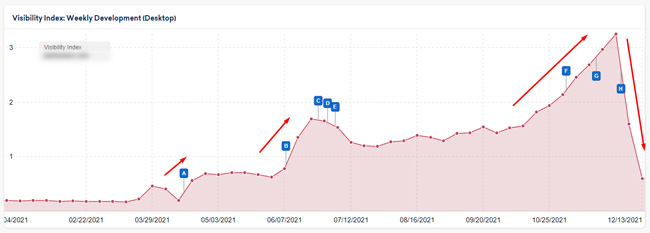
Dueling Machine Learning Systems – Core Updates vs. Product Reviews Update
While analyzing the impact from the December Product Reviews Update, it was interesting to also see the impact from the November broad core update (and the recent broad core updates in June and July of 2021). The November update rolled out on 11/17/2021 and impacted a number of sites in the reviews space. But when the December PRU rolled out, some of those sites reversed course… For example, some sites that dropped with the November broad core update surged with the December PRU (and vice versa). And beyond just the November broad core update, there were many examples of sites surging in June or July and dropping heavily with the December Product Reviews Update. It’s clear the updates were at odds with another…
Here are some examples:



And like I said earlier, there were some sites impacted by the November 2021 core update that reversed course! Talk about dueling machine learning algos… I’m sure those sites were on a roller coaster ride over the past few weeks.


I think this emphasizes a very important point about major algorithm updates like broad core updates and the Product Reviews Update. When Google is using different machine learning systems, those systems can be at odds. If a site gets hammered by a broad core update, yet surges with another major algorithm update like the Product Reviews Update, which one is right?
As Bing has explained in the past about its core ranking algorithm, it sends thousands of signals to the machine learning system and the system determines the weighting (and ultimately where sites will rank). So even Bing’s search engineers don’t even know how powerful certain signals are. That’s why it’s impossible to try and figure out the one or two things causing problems with a site… And its also why I have used a “kitchen sink” approach to remediation with my clients. Don’t try to focus on one or two problems… surface as many as you can and fix them all (or as many as you can).
Here is Bing’s Fabrice Canel explaining more about Bing’s machine learning approach to rankings:
And here is Google’s Alan Kent mentioning Google’s machine learning system used for the Product Reviews Update:
In addition, John Mueller was asked in a Search Central Hangout if the Product Reviews Update is using machine learning to train the algorithm, if human reviewers were used, etc. John explained that for updates like the PRU, it’s not something where human reviewers would be in the loop. And he explained that Google uses a lot of machine learning overall, so yes, it’s probably being used to some extent (reinforcing what Alan explained above). Again, this is important to understand.
You can watch the video below to hear John’s comments:
This is also why I believe John Mueller’s comments about baking the Product Reviews Update into Google’s core ranking algorithm makes complete sense. I’m not sure you can have multiple major algorithm updates that cause the same site to surge one minute, then drop the next. Those algorithms need to work together in my opinion. If not, they will surely drive site owners insane.
When Will The Product Reviews Update Expand To Other Languages (Beyond English)?
The current Product Reviews algorithm impacts English language content globally and does not impact other languages at this point. Google’s John Mueller has been asked when the PRU will expand to other languages and he addressed this in a recent Search Central Hangout.
John explained that they have nothing to pre-announce about expansion, but Google’s goal is to roll out algorithms like this to other languages. He also explained that for some updates, the team at Google works fast to roll things out to other languages. And for others, it’s a slower process. John also explained that there are sometimes policy and legal reasons that can slow things down.
You can watch the video below at 46:17 to hear John’s response:
Sites Gaining or Losing Rich Snippets – Yep, it’s clear.
It’s also important to understand that rich snippets can be impacted by broad core updates and other major algorithm updates (like the PRU). You can read my blog post about that topic to learn more. This can happen when Google reevaluates site quality overall. For example, it’s not uncommon for sites to gain or lose review snippets, FAQ snippets, etc. when a broad core update rolls out (or other major algorithm updates like the Product Reviews Update).
With the December 2021 Product Reviews Update, I saw more of that happening. It’s important for site owners to understand this since rich snippets can absolutely impact click through rate from the SERPs. The additional real estate and visual treatment of rich snippets can attract eyeballs as people scan the SERPs. You don’t want to lose rich snippets if you have them.
Here is an example of a site that surged during the December 2021 Product Reviews Update and it received FAQ snippets back. This is after losing them during the April Product Reviews Update.
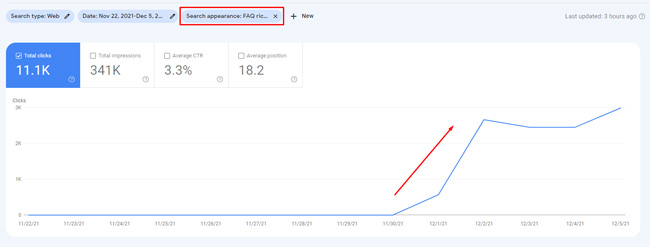
But, as you can see below, it was short-lived. The site has continued to do well rankings-wise, but Google stopped showing FAQ snippets for the site. Sometimes Google is just not showing FAQs at all in the SERPs and sometimes other sites do have them. It’s been volatile from a SERP features standpoint, that’s for sure.

Below, you can see FAQ snippet tracking for the domain (visibility-wise). It spikes with the rollout, then drops as Semrush begins picking up the loss of snippets:

But as I explained on Twitter during the rollout, I saw other strange things happening with rich snippets (and especially FAQ snippets). For example, I saw some sites losing FAQ snippets completely, I saw some *SERPs* losing them completely, and then I saw FAQ snippets replaced by jumplinks (when a page included a table of contents with named anchors for each product reviewed). So, just a heads-up to check your rich snippets if you’ve been impacted by the December Product Reviews Update.
Here is an example of jumplinks showing the top products being reviewed in the post (which I saw replace FAQ snippets during the rollout). It seems Google is testing the best SERP treatment.

Large publishers with reviews content – The PRU will find you.
The Product Reviews Update is supposed to be focused on reviews content, so what happens when large publishers contain reviews content, in addition to a ton of other types of content? Well, the PRU can find that content and those sites can see volatility there. I’ve seen this many times while analyzing both the April and December Product Reviews Updates.
So, it’s easy to think that the PRU didn’t impact your site, but it might have impacted reviews content significantly (whether that’s in specific sections or mixed throughout the site). I just wanted to bring this up in case larger publishers had questions about their reviews content blended into their overall content on the site (since those sites can have hundreds of thousands of pages indexed, or more).
For example, here is specific reviews content within large publishers being impacted. These are sites with a ton of different content, but they do also have reviews.



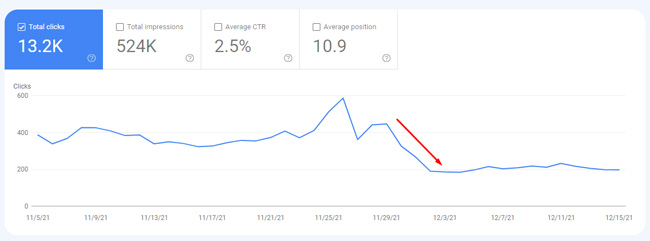
Google’s new guidance for review sites NOT applied yet. And that’s pretty clear.
In Google’s latest blog post about the December Product Reviews Update, it provided more guidance for site owners (beyond the guidance in their original blog post). It’s important to understand that the new guidance is NOT being applied yet from a ranking perspective. I bring that up since many site owners were concerned about the second piece of guidance, which covered linking to multiple stores so people have more choice when deciding to purchase the products being reviewed.
As I mentioned earlier, affiliate marketers could end up violating Amazon’s terms of service (TOS) by linking to other retailers from their product reviews, so that bullet caught the attention of many marketers. So, this is a big heads-up to any site providing reviews that is just linking to one retailer (like Amazon). I’m not sure how this will work down the line, and if Google will change its stance on the topic. Again, it’s not being used now as a factor for the Product Reviews Update, but sure looks like it might with the next update.
For example, you’ll often see review sites linking to just Amazon:

And to confirm this isn’t really being used yet, I noticed a number of review sites that surged that still only link to one retailer (often Amazon). So again, this is more of a heads-up for affiliate marketers:

The PRU Proves Links Aren’t Everything (Just like the April PRU proved):
I covered this in my post about the April Product Reviews Update, and site owners that are overly focused on links should definitely be aware of this. There are many review sites that surged that had much weaker link profiles than competitors.
For example, some sites surging through the roof have under 10K links total, with some having less than 5K links total. And when comparing links from authoritative sites (which is important from an authority standpoint), the comparisons weren’t even close. Sure, they had some powerful links, but not even close to some competitors that dropped.
So yes, links matter. But no, they aren’t the end-all (and especially based on the Product Reviews updates). For example, here are two examples of sites surging during the December Product Reviews Update. Their link profiles are much weaker than many competitors.
Yes, that’s a site with 3.3K links surging during the December Product Reviews Update (and 1.7K after what Majestic calls “noise reduction”):

And here is a site with just 11.8K links surging too (5.1K after “noise reduction”). And it’s competing with sites that have hundreds of thousands (or even millions) of links:

Intent Shift(ing) – Review Sites Appear, and Disappear, For Head Terms
One important finding that others have seen as well was Google changing the SERP for head terms that don’t contain “best”, “top”, or “reviews” in the query. For example, searching for just humidifiers versus “best humidifiers”. During the rollout, I’ve seen a ton of volatility with this. Sometimes the SERPs contain review sites and sometimes they don’t… When they don’t, retailers rank since Google believes the intent is to buy versus find reviews. But again, this has been changing a lot during the rollout. And some sites are jumping all over the place as Google changes the SERPs.
So if you’ve been impacted by the December Product Reviews Update, definitely dig into the queries that dropped or surged. And see if you are part of the reviews dance going on the search results.
Here is a good example. For a specific head term, this product reviews site has suddenly showed up on page one, dropped from page one, show up, dropped, etc. during the rollout. When this happens across head terms, it can sure cause a lot of volatility:

Also, Lily Ray has covered similar things on Twitter (with regard to the companies/products being reviewed jumping up the SERPs versus the sites reviewing them). Here is one of her tweets covering that:
Product Reviews Winners: A quick review of what’s working well with reviews content:
My original post about the April Product Reviews Update covers a lot of information about high quality reviews content. So you should definitely check out that post for more information detailing the various aspects of insightful and valuable reviews. That said, I did want to revisit review content to explain more about what I’m seeing that works well, what’s helpful for users, and what Google seems to be rewarding.
Note, not every site surging provides incredible reviews content. I mentioned that in my post about the April PRU, but I would always strive to provide the highest quality content you can (and follow the guidelines that Google has provided). It’s your safest bet for steering clear of a drop during a subsequent Product Reviews Update.
Here are some additional insights based on analyzing reviews that are being rewarded:
The Power of Organization:
Comparison charts are super-helpful for reviews content. I noticed more and more of this on sites benefiting from the December Product Reviews Update. When comparing multiple products, organizing all the details can help users get a lay of the land.
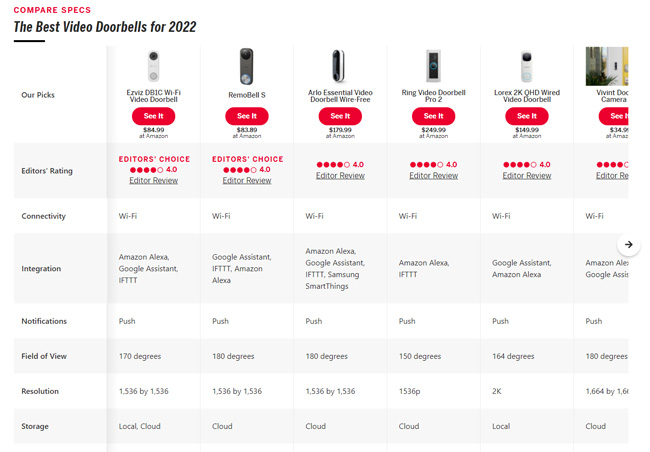



Strong Visuals (Photos, Videos, and Gifs):
When looking for help with choosing the right product, killer visuals can clearly help users. If you provide reviews content, I would think way beyond a stock manufacturer photo and provide original photos of the product you are reviewing (if possible). In addition, providing video of the product so users can get a strong feel for the item can really help readers. And providing quick gifs of how things work can also be beneficial.
Here is a series of visuals for a specific product review:

Here is Wirecutter showing off several bike racks:

Actual experience using the product. Prove you really tested the product and understand the pros and cons:
When reviewing a lot of product reviews content (see what I did there?), it was easy to see when the person reviewing that product truly used it, tested it, etc. Those reviews went way beyond superficial reviews, and I really dug that. By the way, one of Google’s latest guidelines explains that reviews should provide this level of detail. I agree, and it’s clear that Google is trying to surface those types of reviews in the search results. You don’t have to look further than Wirecutter to see examples of this type of review. More about “The Wirecutter Standard” soon.

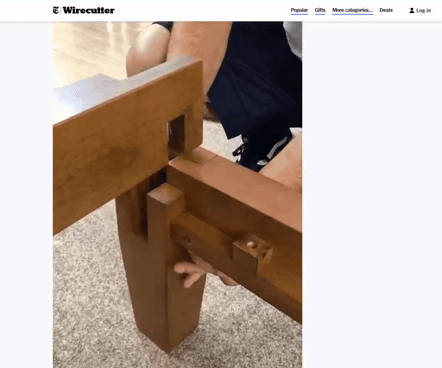
And as I covered in my post about the April Product Reviews Update, make sure experts or enthusiasts are writing the articles (author expertise). After analyzing many reviews, you could clearly tell when the author had a lot of experience in the topic they were covering. And no, just having an expert write the content doesn’t mean it will be super high quality. But, making sure someone has expertise in the subject matter they are writing about can clearly help drive insightful, helpful, and high quality content. In other words, don’t just have anyone writing your reviews content.
Explain your review process and why people should trust you:
When people are searching for reviews, providing your review process clearly for readers is a smart idea (and can help break down barriers). Explain how you review products, the process you take, the metrics you are using to rate products, how you chose the top products per category, and more.
If you want a good example of how this looks, you should check out Wirecuttter. They provide that information in each review. Safewise also provides a section covering how they review products, but it’s at the end of the review. In my opinion, I would put that higher up the page to help users understand that process before reading the reviews. That said, they at least provide that information for readers.
Here is a section from a safewise review for wireless cameras:

And here is a section from a Wirecutter review about why you should trust them:
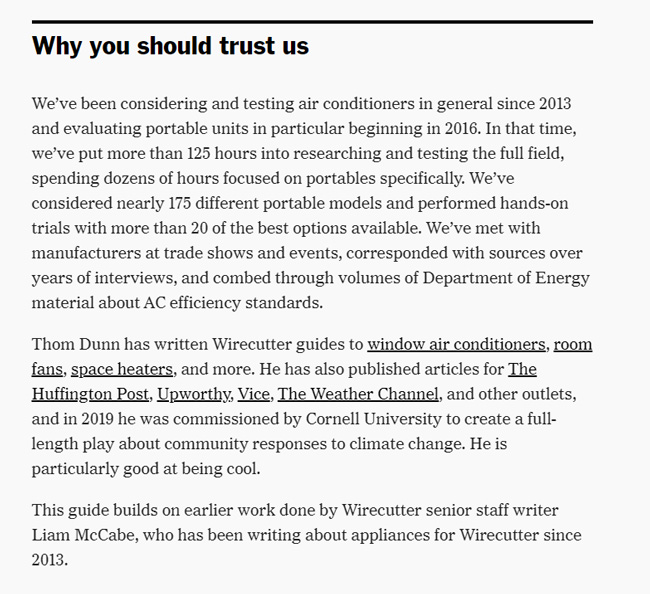
The Wirecutter Standard: Try to be the Wirecutter for your niche. You can’t go wrong.
I mentioned Wirecutter earlier, just provided a bunch of examples from the site, and also covered it heavily in my post about the April Product Reviews Update, and all for good reason. Wirecutter provides some of the most thorough, high quality, insightful, and helpful reviews on the web. And it’s no coincidence they have done very well over time rankings-wise.
When helping companies focused on reviews, I find myself often saying, “be the Wirecutter for your niche”. I know that’s not an easy thing to do, since Wirecutter has a killer team of writers, people testing products, editors, etc., but it’s what many sites should strive for in my opinion. I recommend spending some time on their site, seeing how they break down reviews, the level of detail provided, and try to emulate that for your own niche.


Summary: Understand The April PRU, Learn About The December Update, and Get Ready For The Next
Like the April Product Reviews Update, the December PRU was significant for many sites focused on reviews. It was core update-like for many, yielding surges, drops, and recoveries across verticals. If you have been impacted by the December PRU, I recommend reading Google’s blog posts about the updates, my post about the April Product Reviews Update, review this post about the December update again, and then objectively analyze your own site.
I would surface gaps in your reviews content and fill those gaps, improve the user experience, watch the aggressive ad situation, and work to become the Wirecutter of your niche. Don’t improve a little… make BIG changes. Remember, there are dueling machine learning systems out there looking to surface the highest quality content possible. Control what you can control. That’s the best path forward in my opinion.
GG
Back to table of contents


